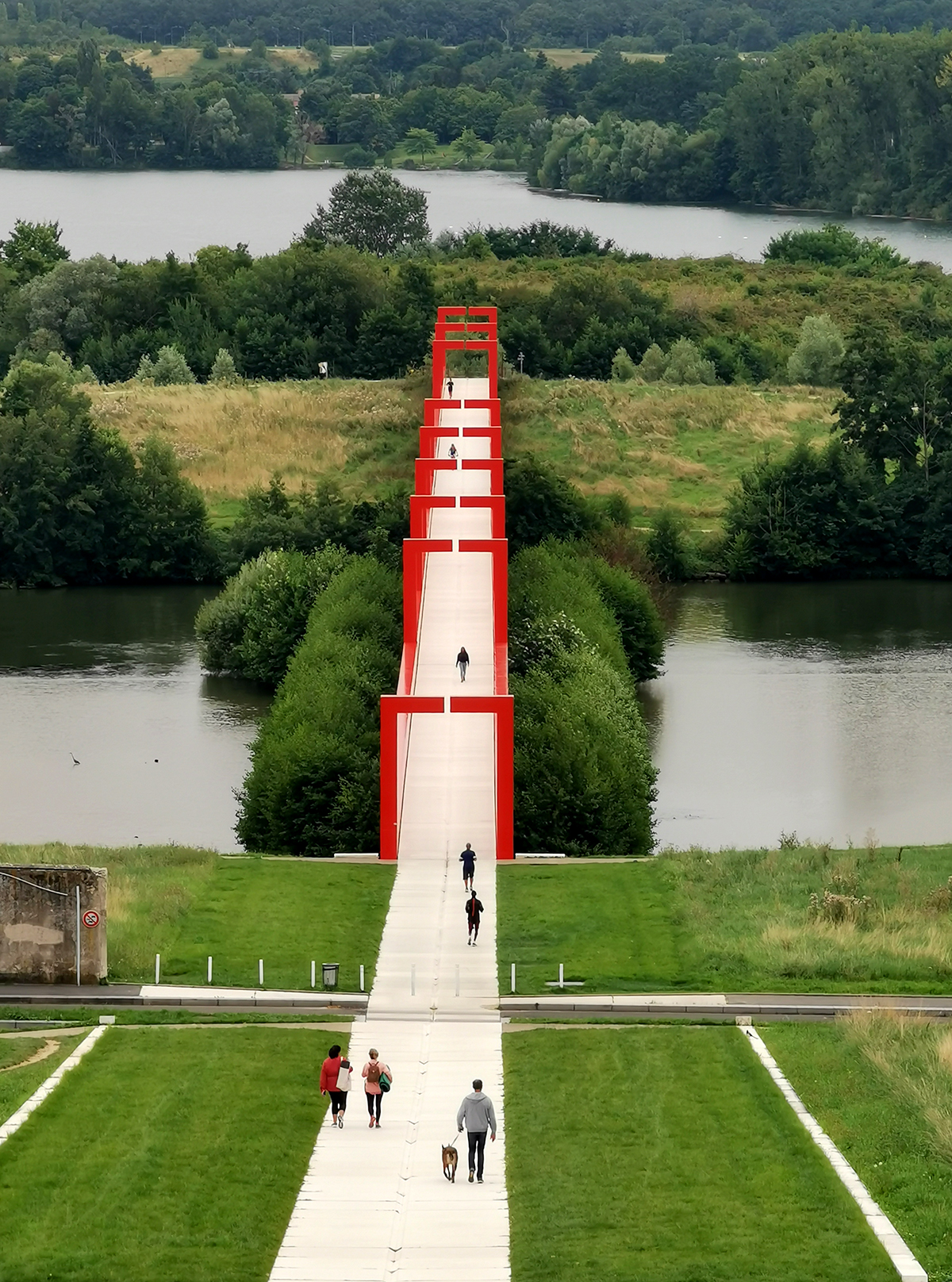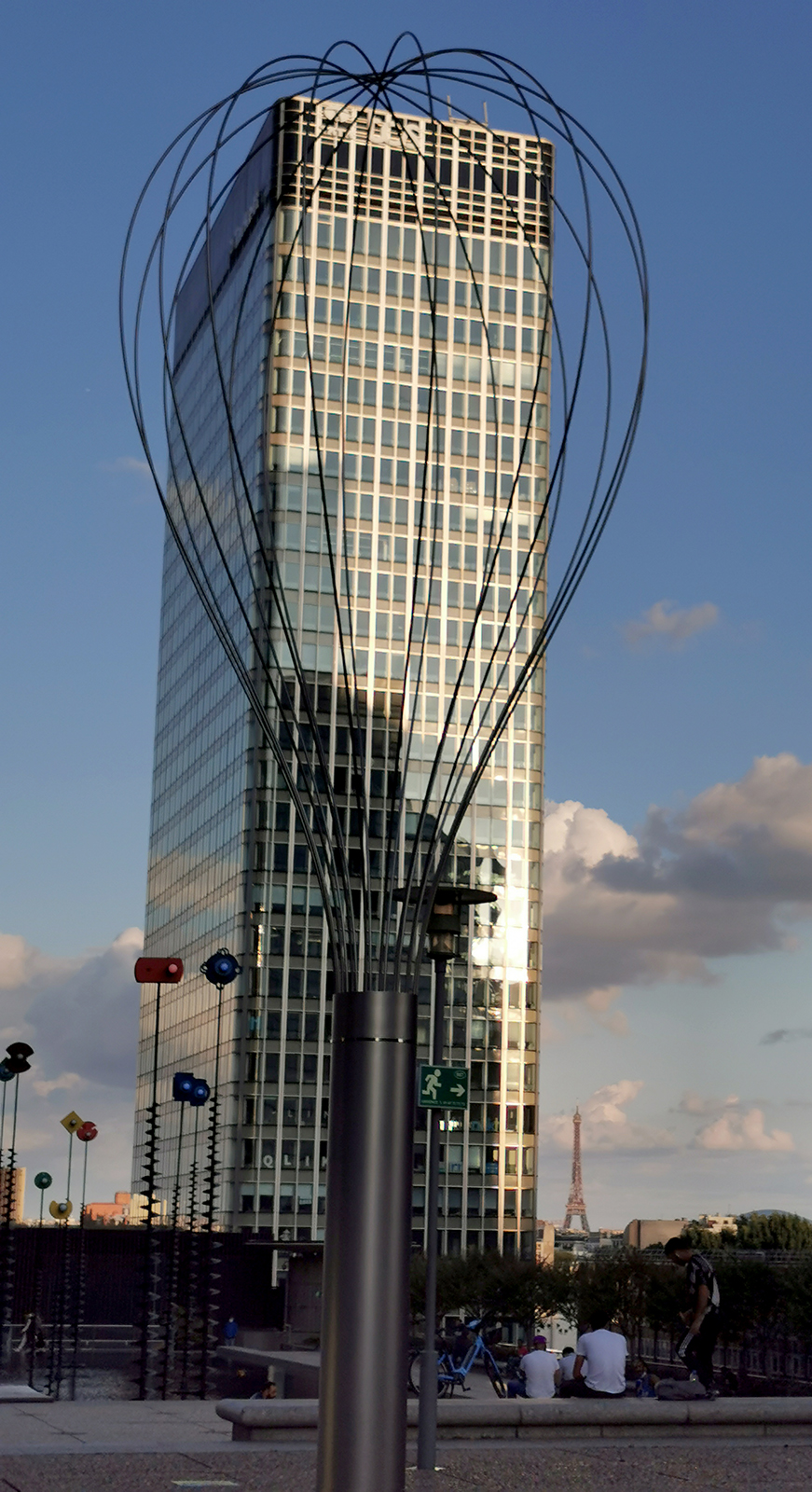The connection between Cergy-Pontoise and La Défense
Sometimes getting out of town means just going to the suburbs. Here’s two daytrips Cergy-Pontoise and La Défense, both just outside Paris to the west that are linked by monumental art, villes nouvelles construction and that you can see one from the other.
L’Axe majeur at Cergy-Pontoise
In the 1960s, faced with the fast development of Paris and its suburbs which lead to a housing crisis and people living in shantytowns, it was decided to control and balance the developement by creating several new cities around Paris. These were Évry, Cergy-Pontoise, Marne-la-Vallée, Sénart and Saint-Quentin-en-Yvelines. There were some smaller projects too like our town center in Villepreux.
The site chosen for Cergy-Pontoise was selected for its interesting and unusual landscape which is around and above a meander in the Oise River. The town was created in an amphitheater around the curve of water. The horseshoe shape gave it a unique administrative organization. It was created in small islands grouped around elementary schools. Cars were kept outside the housing islands and children could walk to school safely. Public art was introduced in many of the new cities and Cergy got a masterpiece.
The Axe Majeur, conceived by artist Dani Karavan, who just died in 2021, stands at the center of Cergy’s horsehoe up on the hill over the river bank. The 3km long work of art then goes down a lot of steps to the river bank and crosses the Oise on a red footbridge that resembles Japanese gates or brings to mind Christo’s Central Park gates. The Axe is composed of twelve stations and the number 12 is repeated in various multiples over and over again in the symbolism of time. The Belvedere Tower is at the leading end of the linear art. It projects a laser beam to the bottom of the work, is 36 meters tall (3×12) and 3.6 meters square. Other features are the 12 columns, the integrated amphitheater with it’s background of water, an orchard, etc. To take this seemingly aerial photo we were simply at the top looking down towards the bottom. Kudos, by the way, to the city of Cergy (or whomever is the caretaker) for keeping the bridge paint bright red and graffiti free. Such a treat! The view, the bridge and the whole make this an extraordinary visit. https://www.axe-majeur.fr/menu-axe-majeur.html
Take the RER to the station Cergy Saint-Christophe. More beautiful photos https://www.instagram.com/axemajeur_cergypontoise/
From the 12 columns at the brink, looking back toward Paris, we had a nice view of La Défense, the skyscraper area to the west of Paris.
La Défense
It had been 30 years since our last visit to La Défense, but after seeing it from Cergy we were inspired to go back. Our last visit coincided with the inauguration of Grande Arche in 1989. This time we started by going to the top of the Grande Arche. First we peered at the lovely view of Paris on the east side. Then on the west in the far distance we were able to pick out, with binoculars, the Axe Majeur on the hillside of the Oise. What fun it was to connect the Cergy-Pontoise and La Défense.
After the visit to the top we walked around on the ground. The area was constructed starting in the mid-50s, the skyscrapers date from the 60s to today. They are pretty modest for skyscrapers, 35-55 stories but in comparison to the rest of Paris the seem quite tall. There is contemporary art in the open space of the esplanade and no cars – they are all underground which makes for harrowing driving – but so nice when walking to be amongst the buildings and art works and watch them play off each other with no noise. Many people complain the area is ugly. We both rather liked it; finding whimsy and perspective, enjoying sunken gardens with cool picnic tables and hamacks…
One dis-used blocky building called CB3 was featured in a New York Times article recently. It gave us another impetus to re-visit La Défense. The building has WIDE overhangs on the sidewalks and reflective windows. There is little activity in the sense of passers-by and lots of space around this building. These elements have made it an ideal outdoor, free, dance studio for K-pop mimickers. There wasn’t much going on dance-wise when we visited, but I loved the idea of groups of young people getting together to dance. According to the NYT article quite a few groups gather there to rehearse and perfect their moves before filming themselves in front of the Eiffel Tower and the like. The building is scheduled to be renovated, so I hope the dancers can find a new spot or that the powers that be can create one for them, a dance park kind of like a skate park – why not?!
One of the questions that comes to mind when visiting La Défense is the name. It is a strange name for a neighborhood. It stems from the traffic circle that preceded the building of the ville nouvelle and skyscrapers. The area was surrounded by shantytowns and small factories but in the center of the circle was a bronze of the city of Paris, represented by a maiden in a national guard uniform, defending herself against the Prussian forces in 1870. This is the only 19th century sculpture amongst the contemporary art of the modern La Défense. This blog shows a nice set of photos of what the space looked like in 1958 when the new city was started with the CNIT.
Cergy-Pontoise and La Défense connect asVilles Nouvelles. Like the others La Défense started out being homogeneous façades around a vast square. The interiors were designed to be the ideal spaces to live and work with lots of daylight. The oldest building is the triangular CNIT (originally the Centre de Nouvelles Industries etTechnologies). The first skyscraper, closest tower to the Seine, was the Nobel (think dynamite and prize) building, now called the Tour Initial. It was completed in 1966 and renovated in 2003. The tallest tower is the First Tower which is 55 stories and 231 meters (remember the Eiffel Tower is 300m). This is the building that has a sort of helicoidal point on top.
The 1970s brought the RER, a wider diversity of buildings, the first public art including a Calder and a Miro, but economic crisis left much of the space un-used. Rennaissance came in the 1980s with the enormous shopping mall the Quatre Temps (add the CNIT which is now shopping and hotel space to make the largest shopping center in Europe). The next decade brought lots more renovation, La Grande Arche, a G7 conference brought international notoriety and the rest, as say the say, is history.
Today La Défense is
- 1 Museum of the automobile
- 2 cool water bassins called Agam and Takis after their designers
- 6 food trucks
- 15 Fortune 500 companies
- 60 bars and restaurants
- 61 skyscrapers
- 69 sculptures https://parisladefense.com/fr/decouvrir/oeuvres-art/ plus a temporary expo of 10 more each summer called Les Extatiques
- 40,000 seats at the Paris La Défense Arena (the largest indoor hall in Europe)
- 42,000 residents, 180,000 employees, 45,000 students
Cergy-Pontoise and La Défense are both well worth a visit and easy to get to.








